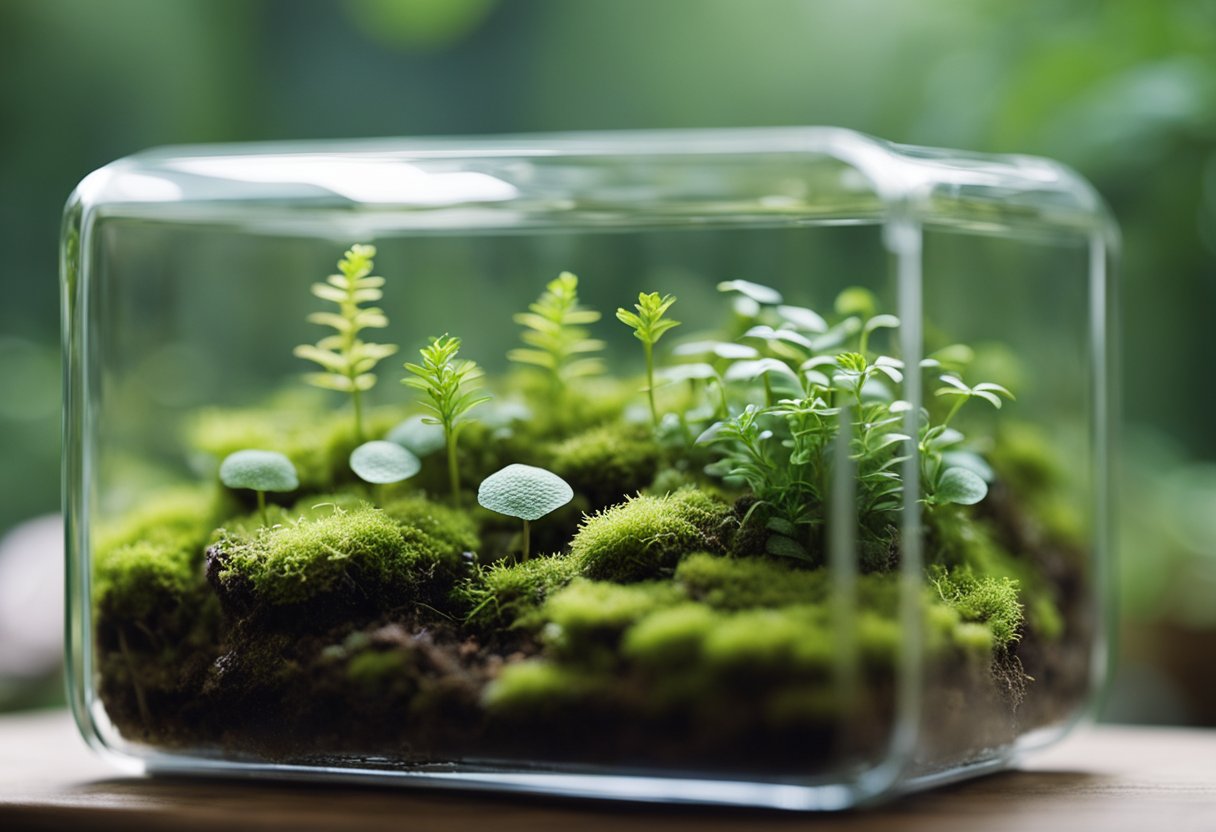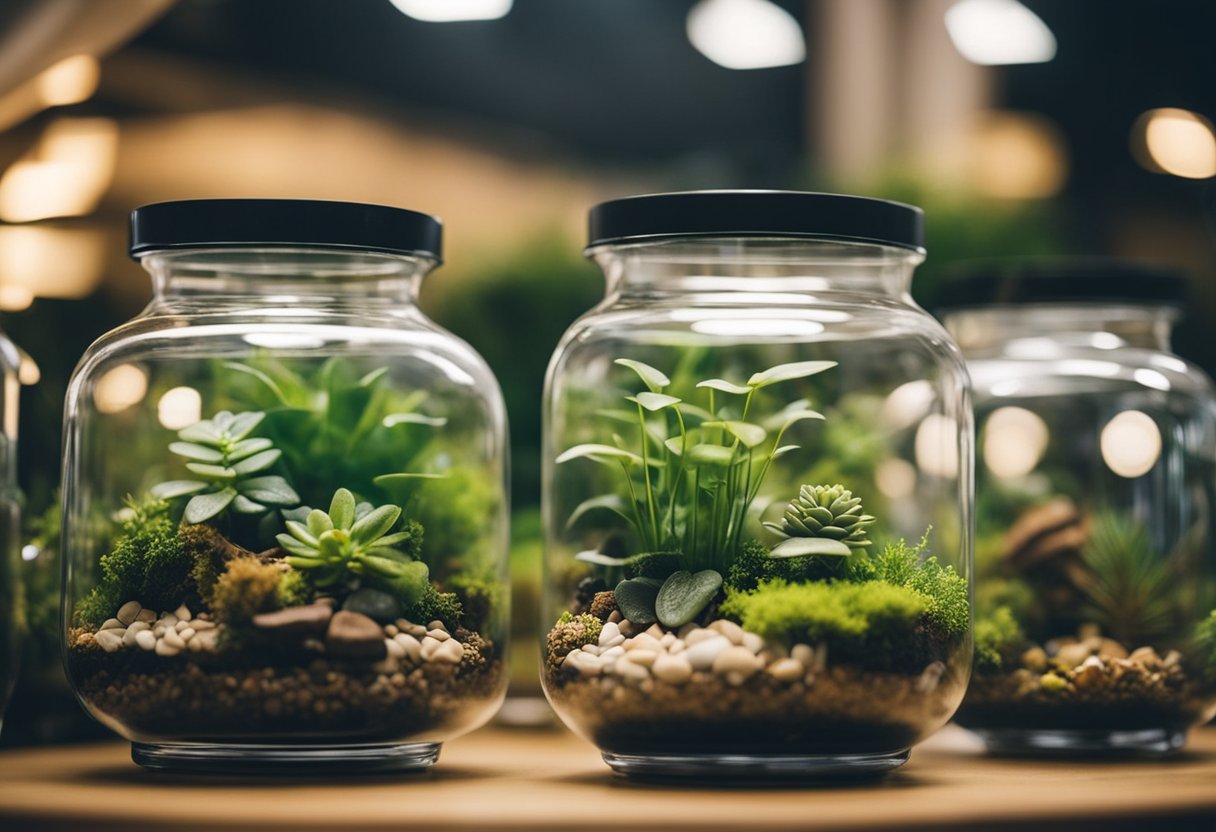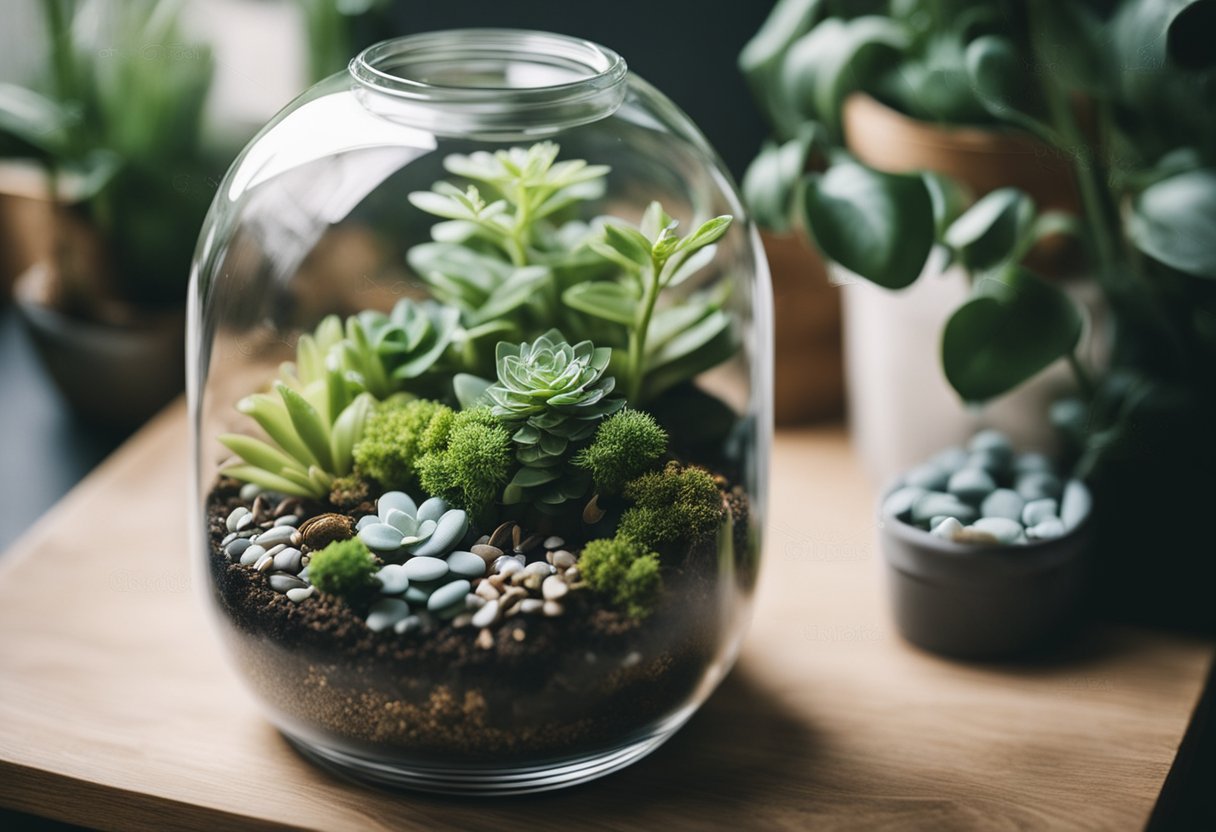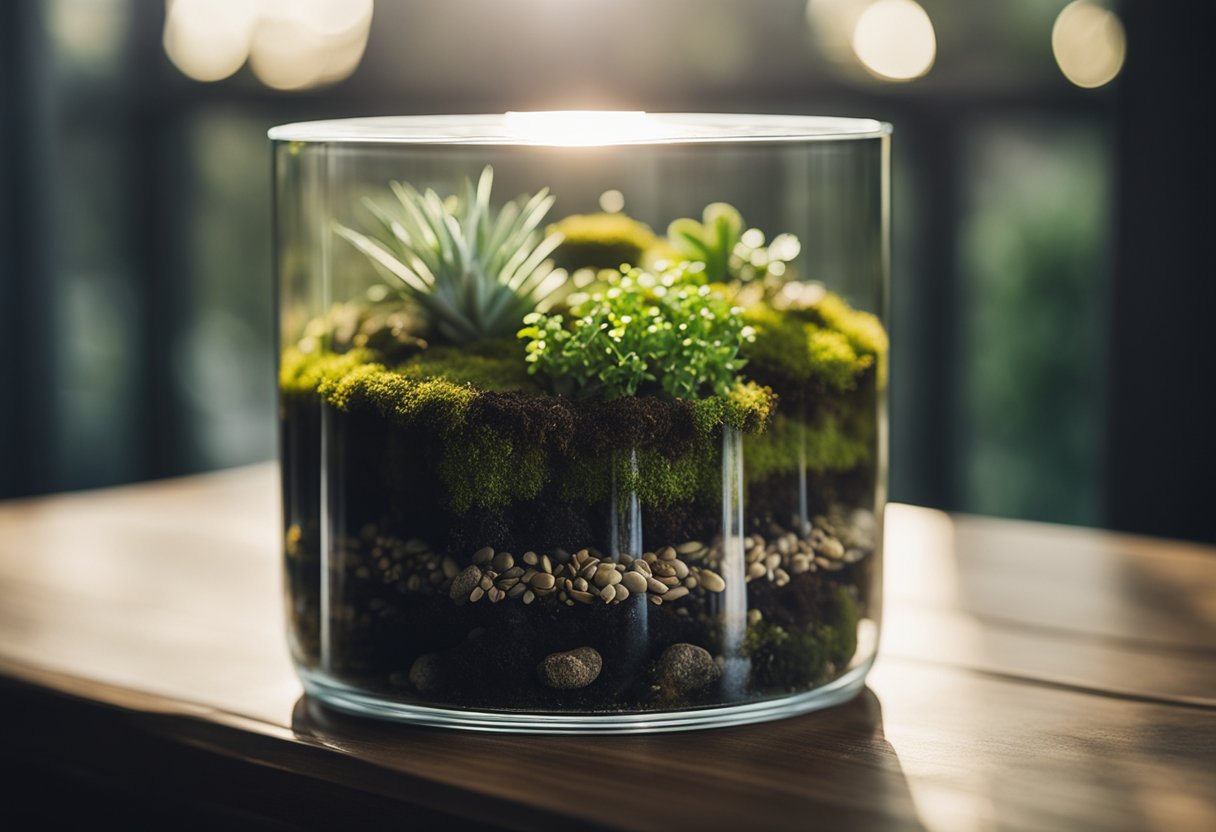Terrariums are a unique and beautiful way to bring a touch of nature into your home or office. These miniature gardens are self-contained ecosystems that require very little maintenance, making them a perfect option for those who want to enjoy the beauty of nature without the hassle of traditional gardening.

Understanding Terrariums is the first step in creating your own. They come in a variety of shapes and sizes, from small glass containers to large open terrariums. The type of terrarium you choose will depend on the plants you want to include, as well as the space you have available. With the right materials and a little bit of know-how, you can create a stunning terrarium that will bring a touch of nature into any space.
Key Takeaways:
- Terrariums are a unique and beautiful way to bring a touch of nature into your home or office.
- Understanding the different types of terrariums and the materials needed to create them is essential to creating a successful terrarium.
- With the right materials and a little bit of know-how, you can create a stunning terrarium that will bring a touch of nature into any space.
Understanding Terrariums

If you’re looking for a way to bring a slice of nature into your home or office, a terrarium might be just the thing. Terrariums are miniature gardens housed inside small glass containers, and they come in two main types: open and closed.
Closed terrariums are sealed containers that create a self-sustaining ecosystem. The plants inside release moisture through transpiration, which then condenses on the glass and drips back down to the soil, essentially creating a miniature water cycle. Closed terrariums require very little maintenance, as the plants inside are mostly self-sustaining.
Open terrariums, on the other hand, are glass enclosures that provide a controlled environment for plants to thrive. Unlike closed terrariums, open terrariums allow air circulation, creating a balanced ecosystem where plants can breathe freely. They require a bit more maintenance than closed terrariums, as you’ll need to water the plants regularly and monitor the soil moisture levels.
Both open and closed terrariums can be self-sustaining, but closed terrariums are generally easier to maintain in this way. If you’re new to terrariums, a closed terrarium might be a good place to start.
One of the great things about terrariums is that they’re customizable. You can choose the plants you want to include, as well as the container and any decorative elements. Some popular terrarium plants include ferns, mosses, and succulents.
When it comes to creating a terrarium, there are a few key things to keep in mind. First, choose a container that’s the right size for the plants you want to include. You’ll also need to choose the right type of soil and make sure you have good drainage.
Overall, terrariums are a fun and low-maintenance way to bring a bit of nature into your home or office. Whether you opt for a closed or open terrarium, you’re sure to enjoy the beauty and tranquility they provide.
Types of Terrariums

If you’re interested in creating a terrarium, it’s important to understand the different types available. Here are some of the most popular types of terrariums:
Closed Terrariums
Closed terrariums are designed for humidity-loving tropical plants. These terrariums are sealed, creating a mini-ecosystem. The moisture from the soil and plants evaporates and condenses on the walls of the container, creating a self-sustaining environment. Closed terrariums are perfect for plants like ferns, mosses, and orchids.
Open Terrariums
Open terrariums are designed for arid plants like cacti and succulents. These terrariums are not sealed and allow for air circulation. Open terrariums are perfect for plants that require good drainage and less moisture.
Geometric Terrariums
Geometric terrariums are a popular choice for those who want to create a modern and stylish terrarium. These terrariums come in a variety of shapes and sizes, including cubes, pyramids, and hexagons. Geometric terrariums are perfect for small succulents and air plants.
Mini Terrariums
Mini terrariums are perfect for those who want to create a small, low-maintenance terrarium. These terrariums can be as small as a few inches in diameter and are perfect for small succulents and air plants.
Glass Dome Terrariums
Glass dome terrariums are a unique type of terrarium that creates a beautiful display. These terrariums are designed to look like a miniature greenhouse and are perfect for plants that require high humidity.
Egg Terrariums
Egg terrariums are a fun and unique way to create a terrarium. These terrariums are designed to look like a bird’s egg and are perfect for small succulents and air plants.
Succulent Terrariums
Succulent terrariums are designed for plants that require good drainage and less moisture. These terrariums are perfect for succulents and cacti.
Overall, there are many different types of terrariums available, each with its own unique features and benefits. Whether you’re interested in a closed terrarium or an open terrarium, there’s a type of terrarium that’s perfect for you.
Materials Needed

Creating a terrarium is an exciting and rewarding experience that requires a few essential materials. In this section, we will go over the materials you need to get started on your own terrarium project.
Containers
The first thing you will need to create a terrarium is a container. You can use various types of containers such as glass jars, glass containers, or even specially designed terrarium containers. The container you choose should be clear to allow for maximum light penetration and visibility of the plants inside.
Soil and Drainage
The next important material you will need is soil and drainage. To ensure proper drainage, you will need to add a layer of gravel or sand at the bottom of your container. On top of the drainage layer, add a layer of activated charcoal to help filter the water. Finally, add a layer of potting soil on top of the activated charcoal.
Plants and Decor
The most exciting part of creating a terrarium is choosing the plants and decor to include. You can choose from a wide variety of plants such as succulents, cacti, ferns, mosses, fittonia, nerve plants, air plants, exotic plants, and even flowers. When selecting plants, consider their light and water requirements to ensure they will thrive in the environment you create. You can also add decorative elements such as rocks, pebbles, figurines, and lights to enhance the visual appeal of your terrarium.
Additional Materials
In addition to the essential materials mentioned above, you may also need additional materials depending on the type of terrarium you are creating. For example, if you are creating a desert terrarium, you may need sand and rocks. If you are creating a forest terrarium, you may need moss and ferns.
DIY Kits
If you are new to creating terrariums, you may want to consider purchasing a DIY kit. These kits typically include all the materials you need to create a basic terrarium, including a container, soil, plants, and decorative elements. DIY kits are a great way to get started on your terrarium journey and can be found at many gardening and craft stores.
Now that you know the essential materials needed to create a terrarium, you can start gathering the supplies and get started on your own project. Have fun and let your creativity run wild!
How to Make a Terrarium

Are you looking for a fun and easy DIY project that will add some greenery to your home or office? Making a terrarium might just be the perfect solution for you! With a few simple materials and some creativity, you can create your very own miniature garden that will bring a touch of nature indoors.
Materials Needed
To make a basic terrarium, you will need the following materials:
- Glass container (such as a jar or bowl)
- Gravel or small stones
- Activated charcoal
- Potting soil
- Small plants (such as succulents or ferns)
- Decorative elements (such as moss or rocks)
You can purchase a terrarium kit that includes all of these materials, or you can gather them individually at a garden center or home improvement store.
Step-by-Step Instructions
- Start by adding a layer of gravel or small stones to the bottom of your container. This will help with drainage and prevent the soil from becoming waterlogged.
- Next, add a layer of activated charcoal on top of the gravel. This will help keep the terrarium fresh by absorbing any odors or toxins.
- Add a layer of potting soil on top of the charcoal. Make sure to leave enough space for your plants to fit comfortably.
- Arrange your plants in the soil, making sure to leave enough space between them for growth. You can use a spoon or small trowel to gently dig holes for the plants.
- Once your plants are in place, add any decorative elements such as rocks or moss.
- Water your terrarium lightly, being careful not to overwater. You can use a spray bottle or watering can with a narrow spout to water your plants.
Tips and Tricks
- Choose plants that are well-suited for terrariums, such as succulents or ferns.
- Make sure your container has a lid if you are creating a closed terrarium.
- Use a long-handled tool such as chopsticks to help arrange your plants and decorative elements.
- Consider adding a layer of sand or decorative gravel on top of the soil for added texture and visual interest.
With these simple steps, you can create a beautiful and unique terrarium that will brighten up any space. So why not get started today and make your own DIY terrarium?
Terrarium Maintenance
Maintaining your terrarium is crucial to ensure the longevity of your plants and the overall health of your closed environment. Here are some tips to help you maintain your terrarium effectively:
Watering
One of the most important aspects of terrarium maintenance is watering. Overwatering can lead to root rot, while underwatering can cause your plants to wilt and die. It’s essential to find the right balance. The amount of water your terrarium needs will depend on the size of your container and the plants you have inside it. As a general rule, water your terrarium when the soil feels dry to the touch. Use a watering can or spray bottle to avoid overwatering.
Maintenance
Maintaining cleanliness is key to keeping your terrarium healthy. High humidity within closed environments can lead to the growth of bacteria, as well as plant fungal issues. Before use, all terrarium glass should be cleaned thoroughly with soap and hot water. Regularly remove any dead leaves or debris from your terrarium to prevent the buildup of harmful bacteria.
Humidity
The humidity level in your terrarium is crucial to the health of your plants. Too much humidity can cause excess water to accumulate, leading to root rot. On the other hand, low humidity can cause your plants to dry out and die. To maintain the optimal humidity level, keep your terrarium in a location with indirect sunlight and good air circulation.
Moisture
Moisture is essential for the growth of your plants, but excess moisture can lead to a buildup of harmful bacteria. To avoid excess moisture, make sure your terrarium has proper drainage and avoid overwatering. If you notice excess condensation on the walls of your terrarium, remove the lid for a few hours to allow the excess moisture to evaporate.
In conclusion, maintaining your terrarium is essential to ensure the health and longevity of your plants. By following these tips, you can keep your terrarium thriving for years to come.
Choosing the Right Plants
When it comes to choosing plants for your terrarium, there are a few things you should consider. First, you need to think about the type of terrarium you have. Is it an open or closed terrarium? Does it have a desert or tropical theme? Once you know the answers to these questions, you can start selecting the right plants.
For open terrariums, you can choose a variety of plants, including succulents, cacti, ferns, and mosses. These plants thrive in environments with good air circulation and lower humidity levels. Succulents and cacti are particularly popular choices as they require little water and can add a desert-like feel to your terrarium.
Closed terrariums, on the other hand, require plants that can thrive in a humid environment. Some good choices include ferns, mosses, and exotic plants. Fittonia, also known as the nerve plant, is a popular choice for closed terrariums as it loves humidity and adds a pop of color with its vibrant leaves.
Air plants are another great option for both open and closed terrariums. These plants don’t require soil and absorb moisture through their leaves, making them perfect for terrariums with limited space.
When selecting plants, it’s important to consider their growth habits and size. You don’t want to choose plants that will outgrow your terrarium or require constant pruning. It’s also a good idea to choose plants with similar light and water requirements to make maintenance easier.
Overall, choosing the right plants for your terrarium can be a fun and exciting process. With a little research and consideration, you can create a beautiful and thriving mini ecosystem in your home.
Terrarium Workshops
If you’re looking for a fun and unique activity to do with friends or colleagues, consider attending a terrarium workshop. These workshops provide a hands-on experience in creating your own miniature garden inside a glass container. With the guidance of experienced instructors, you’ll learn about the different types of plants and materials needed to create a beautiful and thriving terrarium.
Many terrarium workshops in Singapore offer a variety of options to suit different preferences and budgets. Some workshops provide unlimited use of materials, while others offer a specific set of materials for participants to use. Some workshops also specialize in certain types of terrariums, such as hanging globe terrariums or geometrical jars.
In addition to being a fun activity, terrarium workshops can also be a great way to bond with your team or colleagues. Some workshops even offer team-building packages, where participants work together to create a larger terrarium or compete in challenges.
If you’re not sure where to start, consider consulting with a terrarium expert. Many terrarium workshops in Singapore also offer consultation services, where you can get personalized advice on how to create and care for your own terrarium. With the right guidance and materials, you can create a beautiful and unique piece of greenery to brighten up your home or office.
Inspirational Terrarium Ideas
Looking for some inspiration for your next terrarium project? You’ve come to the right place! Here are some exciting and creative ideas to get your green thumb itching:
- Minimalist Zen Garden: Create a serene and calming terrarium with a minimalist design. Use sand or gravel as a base and add a few carefully placed rocks and a small succulent or two. This is perfect for a desk or meditation space.
- Fairy Garden Wonderland: Bring a touch of magic to your home with a whimsical fairy garden terrarium. Use miniature figurines, tiny houses, and plenty of greenery to create a miniature world that will transport you to another realm.
- Natural Landscape: Create a miniature landscape that mimics the natural world. Use moss, ferns, and small plants to create hills, valleys, and even waterfalls. This is a great way to bring the outdoors inside and add some greenery to your home.
- Hanging Terrarium: Turn your terrarium into a hanging work of art by using a glass orb or other hanging container. Fill it with air plants, succulents, or other small plants and hang it in a sunny window for a stunning display.
- Geometric Terrarium: Add some modern flair to your terrarium by using a geometric container. Use succulents or other low-maintenance plants to create a unique and eye-catching display.
- Terrarium Centerpiece: Make a statement at your next dinner party with a terrarium centerpiece. Use a large glass container and fill it with a variety of plants, moss, and other natural elements. Add some candles for a warm and inviting ambiance.
Whether you’re looking to add some greenery to your home decor or create a miniature garden, there are endless possibilities when it comes to terrariums. Get creative and have fun with it!
Frequently Asked Questions
What are some easy-to-care-for plants that work well in a terrarium?
If you’re new to terrariums, you might be wondering what types of plants to use. Some easy-to-care-for plants that work well in a terrarium include ferns, mosses, succulents, and air plants. These plants are low-maintenance and can thrive in the humid environment of a terrarium.
What supplies do I need to create a beautiful terrarium?
To create a beautiful terrarium, you’ll need a few basic supplies. First, you’ll need a container. Glass containers work well for terrariums because they allow light to enter and provide a clear view of the plants. You’ll also need potting soil, rocks or pebbles, activated charcoal, and plants. Additionally, you may want to add decorative elements such as figurines or colored sand.
How do I create a large terrarium that makes a statement?
Creating a large terrarium that makes a statement requires careful planning and attention to detail. Start by choosing a large container that will make an impact. Next, choose a variety of plants in different sizes and textures to create interest. Use rocks and pebbles to create height and depth, and add decorative elements to tie everything together.
What are the benefits of using glass for my terrarium?
Glass is a popular choice for terrariums because it allows light to enter and provides a clear view of the plants. Additionally, glass containers are easy to clean and can be used for a variety of different terrarium styles.
What is a closed terrarium and how do I care for it?
A closed terrarium is a type of terrarium that is sealed to create a self-sustaining ecosystem. To care for a closed terrarium, you’ll need to monitor the moisture levels and make sure the plants are getting enough light. It’s important to avoid overwatering and to keep the terrarium out of direct sunlight.
How can I find the best terrariums on Amazon?
To find the best terrariums on Amazon, start by reading customer reviews and checking the product specifications. Look for terrariums that are made from high-quality materials and are the right size for your needs. Additionally, consider the style and design of the terrarium to make sure it fits with your decor.




